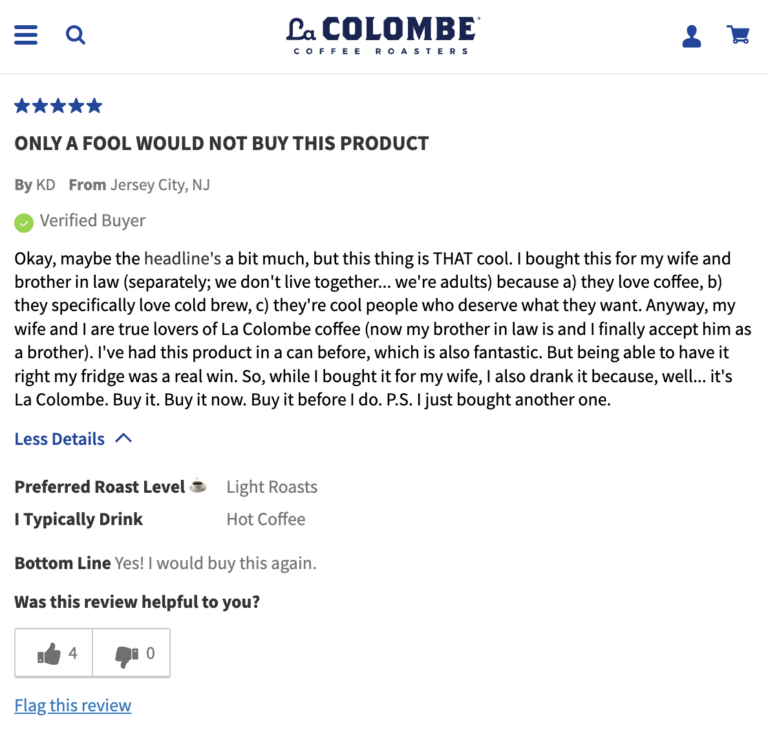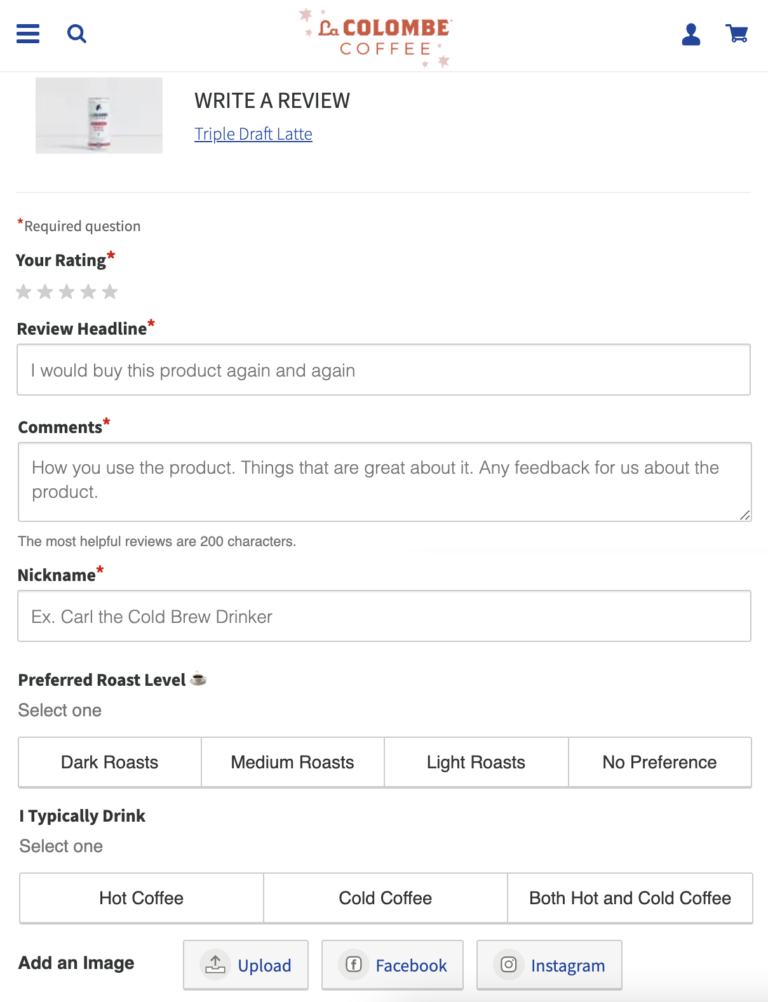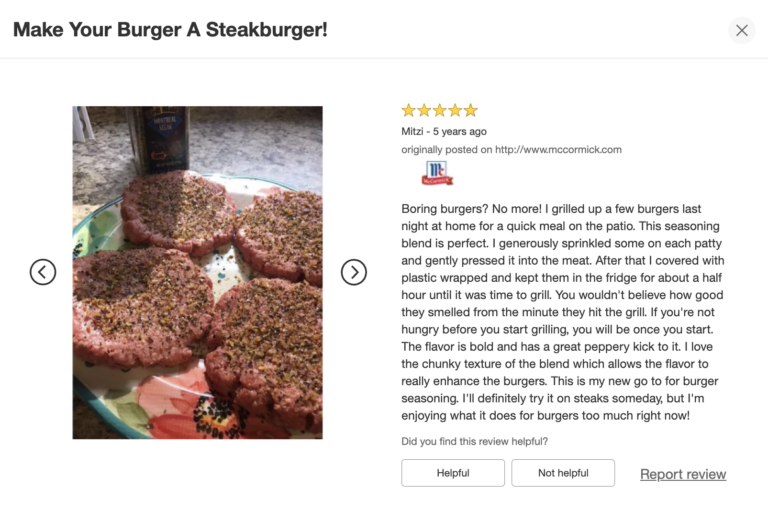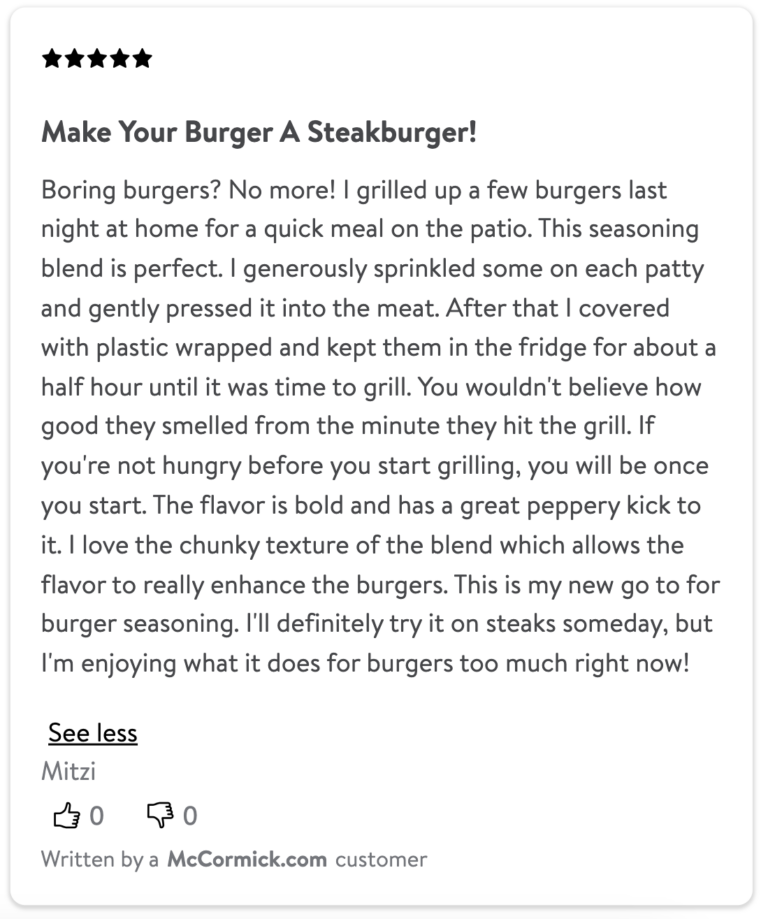What You Need to Know in Under 5 Mins
A major challenge for CPG brands is determining how to stand out among their competitors on the digital shelf. Understanding what it takes in your category is a critical element to success.
With ratings and reviews being the single-most important factor impacting purchase decisions, user-generated content can be the key to unlocking ecommerce success — particularly in a crowded category like CPG.
Got 5 minutes? Perfect. Watch the video below or read on to learn what you need to know about ratings and reviews for the CPG category.
Review Benchmarks: CPG
The following benchmarks come from an analysis of product pages on PowerReviews client sites in the CPG category. We chose these benchmarks because they speak to both review quantity and quality – the two things brands should focus on to deliver a high impact UGC strategy.
80.8%
Review Coverage
4.6
Average Star Rating
201
Average Review Length
235
Reviews per Product
30.3%
Average Media Coverage
80.8% of the CPG products we analyzed have at least 1 review. This positions CPG brands ahead of many other verticals, but given the conversion lift of having just 1 review (see the next section), it is critical that brands strive to collect reviews for all the products on their site.
This is just below the sweet spot we recommend for the optimal conversion lift. Our research shows that products with ratings between 4.75 – 4.99 stars have the highest conversion rates.
Longer reviews tend to have higher conversion rates, as they provide richer detail and more relevant information for shoppers. For the maximum uplift, we recommend a stretch goal of 500 characters per review (around the length of this and the previous bullet combined).
The average CPG product in our analysis has 235 reviews. This is wonderful, as nearly half (43%) of consumers want to see more than 100 reviews per product. Having said that, there is a linear relationship between review volume and conversion rates (again, see the next section), so more reviews is always better.
30.3% of the CPG products we analyzed have at least one user-generated image or a video. Increasing this percentage can work wonders for your conversion rates, as visitors who interact with user-generated photos and videos are 103.9% more likely to convert.
These benchmarks are pretty high in comparison to what we typically see for other categories. But when you consider what makes the CPG category unique, it makes sense. The CPG category carries a lot of replenishment purchases. These are the products that people are buying again and over again, so it’s entirely possible that there’s a larger customer base from which to draw reviews.
For brands with a solid UGC strategy, that can be an advantage: with more people to ask for reviews, the more reviews they can consistently generate to persuade others to purchase — leading to more online traffic and dollars. For brands without a UGC strategy, however, it only makes the category that much more competitive.
How Review Volume Impacts Conversion for CPG Brands
While the average CPG product in our analysis has 235 reviews, we hinted in the above section that more is always better. Here’s why.
The chart below shows the lift in conversion when a customer sees a product page with a certain number of reviews displayed vs. a product page with 0 reviews. You can see there is a direct relationship between review volume and conversion lift.

As you can see, more is more when it comes to reviews. There is a significant uplift in conversion when a product goes from having fewer than 1,000 reviews to more than 1,000. At the same time, 1 review is better than none, so don’t be afraid to just get started!
What Makes a Great CPG Product Review?
It’s important to have a lot of reviews, but those reviews also need a certain depth to them in order to help buyers make buying decisions. When shoppers arrive on your product page, they’re right at the end of the purchase funnel. They are looking for information that is a bit deeper in level of detail to nudge them toward clicking that “Add to Cart” button. That’s where review quality comes in.
So, what makes a quality review for a CPG product? Let’s take a look at this example from La Colombe Coffee Roasters.

Not only does this review make a bold statement that is persuasive on its own (“Only a Fool Would Not Buy This Product”), but it contains a lot of personality and information about who bought this product and who is enjoying it.
The review display also highlights a lot of key information outside of the block of text, such as the reviewer’s coffee preferences (e.g. “Preferred Roast Level”), a “Verified Buyer” badge to build trust, and the bottom line on whether they would purchase this product again (in this case, a resounding yes).
How to Collect CPG Reviews That Convert Browsers Into Buyers
To succeed at UGC, you need to capture reviews that are deep and rich in detail. How do you do that? It’s all about asking the right questions.
In addition to the standard review box, we recommend adding custom questions to your review forms to maximize the actionability of the information you collect. At PowerReviews, we call these Merchant Specific Questions, or MSQs. By adding MSQs, you can squeeze additional information out of reviewers that future shoppers will find useful, such as the best use case for a product, pros and cons, or taste preferences. Plus, by making these MSQs clickable options, as opposed to an open-text field, they are less burdensome on the reviewer to answer.
Avoid adding too many MSQs, though. We find that 8 questions is the sweet spot and once a form becomes much longer than that, we see a higher rate of abandonment. So, choose wisely, and be intentional about what kind of data you want to include on your product display pages to provide your customers with all of the information they need to make an informed purchase.
For MSQ inspiration, take a look at this review form from La Colombe Coffee Roasters.

La Colombe obviously knows their customer, and they know the types of things their customers look for, so they’re looking to elevate that information in the data they capture and display on their product pages.
Once you have optimized your review form, it’s time to go out and collect those reviews! Try asking for reviews via your:
-
- Sending post-purchase email
- Asking for reviews on receipts and invoices
- Including review requests in your product packaging
- Asking for reviews via text or social media
- Hosting a review sweepstakes or contest
- Offering loyalty points in return for a review
- Running a product sampling campaign
Bonus Step: Syndicate Your Reviews for Maximum Impact
Soon you’ll be collecting lots of detail-rich reviews on your website, and in high volumes, too. Congratulations! But the work’s not quite over just yet. To truly maximize the value of those reviews, you need to ensure that those reviews are showing up in all the same places your shoppers are.
For CPG brands, that often includes retailers like Albertsons, Walmart, Target, and Amazon. Enter: UGC Syndication by PowerReviews. When you set up review syndication, your customers only have to write a review once. Then that review gets posted not only to your website, but to your biggest retail partners as well!


When setting up review syndication, the key is to focus on the biggest traffic websites that will have the biggest upside for you. You can find these using your sales data. You’ll likely ultimately get a bigger boost in revenue by maximizing your review footprint on one of these higher-traffic websites than a less-trafficked, lower-impact website.
Ready to beat your competition and help more consumers discover your CPG products?
Contact PowerReviews to learn more about how UGC can grow your business.





